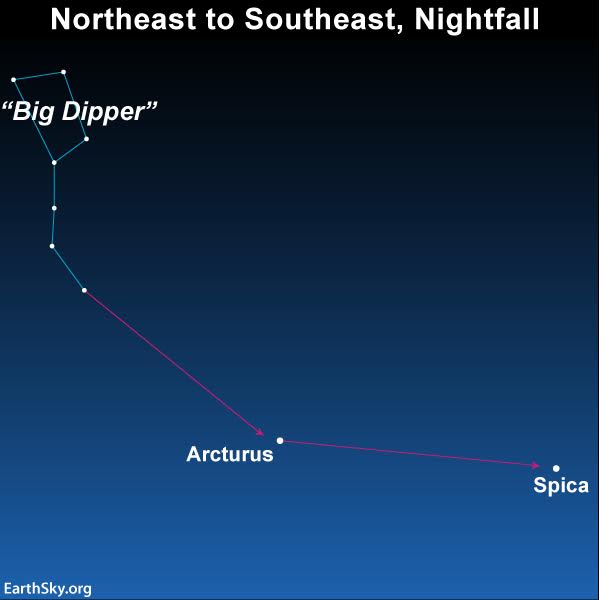
On April 16, 17 and 18, 2019, find the bright waxing gibbous moon moving between two bright and beautiful stars in two different constellations, Arcturus and Spica. Arcturus is part of the constellation Bootes the Herdsman. Spica is part of the constellation Virgo the Maiden. Both stars are bright, so bright that you might notice that Arcturus is a yellow-orange star, while Spica is bluish in color.
We in the Northern Hemisphere consider these two stars as signs of springtime. Sparkling above the eastern horizon at early evening at this time of year, they travel westward (along with the moon) throughout the night as Earth spins under the sky. This month, Arcturus and Spica shine at their highest in the sky around midnight, and they can be found descending in the west as dawn starts to color the sky.
You can recognize Arcturus and Spica any evening by finding the Big Dipper in the northern sky and remembering this stargazing mnemonic: follow the arc to Arcturus, drive a spike (or speed on) to Spica. At nightfall, the Big Dipper stands on its handle in your northeast sky, looking like a kite flying in the wind.The chart below shows you how it’s done.

Extend the arc of the Big Dipper handle to arc to the orange star Arcturus. Then speed on to bluish Spica! Read more.
At the same time each night, watch for the moon to move closer to these two bright stars, and to pass between them on or near April 18, 2019. The moon will pass to pass to the north of Spica, and to the south of Arcturus.
Although yellow-orange Arcturus appears brighter than blue-white Spica to our eye, that’s only because Spica is so much farther away from us. Arcturus resides about 37 light-years away, whereas Spica lies some 7 times farther off than that, at 260 light-years distant. If Arcturus stood at the sun’s distance from us, it’d shine over 100 times more brightly than the sun. But Spica at the sun’s distance away would shine with the firepower of over 2,000 suns!
Read more: Star brightness versus star luminosity
Bottom line: Use the moon to find Arcturus and Spica, and then use the Big Dipper to locate these colorful stars for months to come!
from EarthSky http://bit.ly/2V5QkbG

On April 16, 17 and 18, 2019, find the bright waxing gibbous moon moving between two bright and beautiful stars in two different constellations, Arcturus and Spica. Arcturus is part of the constellation Bootes the Herdsman. Spica is part of the constellation Virgo the Maiden. Both stars are bright, so bright that you might notice that Arcturus is a yellow-orange star, while Spica is bluish in color.
We in the Northern Hemisphere consider these two stars as signs of springtime. Sparkling above the eastern horizon at early evening at this time of year, they travel westward (along with the moon) throughout the night as Earth spins under the sky. This month, Arcturus and Spica shine at their highest in the sky around midnight, and they can be found descending in the west as dawn starts to color the sky.
You can recognize Arcturus and Spica any evening by finding the Big Dipper in the northern sky and remembering this stargazing mnemonic: follow the arc to Arcturus, drive a spike (or speed on) to Spica. At nightfall, the Big Dipper stands on its handle in your northeast sky, looking like a kite flying in the wind.The chart below shows you how it’s done.

Extend the arc of the Big Dipper handle to arc to the orange star Arcturus. Then speed on to bluish Spica! Read more.
At the same time each night, watch for the moon to move closer to these two bright stars, and to pass between them on or near April 18, 2019. The moon will pass to pass to the north of Spica, and to the south of Arcturus.
Although yellow-orange Arcturus appears brighter than blue-white Spica to our eye, that’s only because Spica is so much farther away from us. Arcturus resides about 37 light-years away, whereas Spica lies some 7 times farther off than that, at 260 light-years distant. If Arcturus stood at the sun’s distance from us, it’d shine over 100 times more brightly than the sun. But Spica at the sun’s distance away would shine with the firepower of over 2,000 suns!
Read more: Star brightness versus star luminosity
Bottom line: Use the moon to find Arcturus and Spica, and then use the Big Dipper to locate these colorful stars for months to come!
from EarthSky http://bit.ly/2V5QkbG

Aucun commentaire:
Enregistrer un commentaire